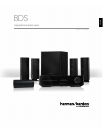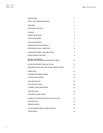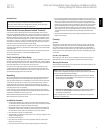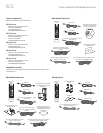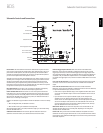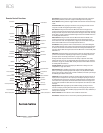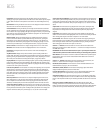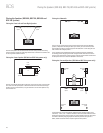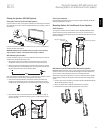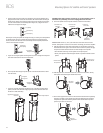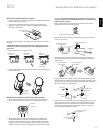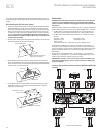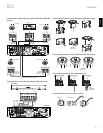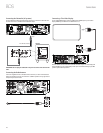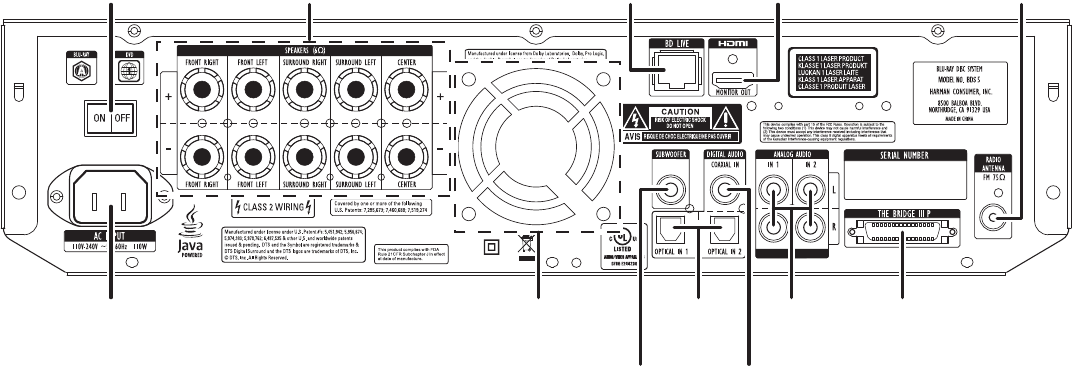
BDS
6
Receiver Rear-Panel Connections
NOTE: See the Connections section, on page 14, for detailed information about making
connections.
AC Power Connector: After you have made and verified all other connections, plug the
supplied AC power cord into this input and into an unswitched AC outlet.
Main Power Switch: This mechanical switch turns the BDS receiver’s power supply on or
off. After you have made and verified all connections (see the Connections section, on page
14), set this switch in the On position. During normal use you will usually leave this switch set
to On; it cannot be turned on or off using the remote control. To conserve energy when you’re
not going to be using the receiver for an extended period of time, set this switch to Off.
Speaker Connectors: Use the speaker wires supplied with the speakers to connect the
satellite and center speakers to the proper terminals.
The
t
BDS 5 receiver (shown) has connections for five speakers: front left, front right,
surround left, surround right and center.
The
t
BDS 2 receiver (not shown) has connections for two speakers: front left and front
right.
See Connections, on page 14, for more information.
Subwoofer Output: Use the supplied mono RCA audio cable (with the purple connectors)
to connect this jack to the subwoofer’s Line-Level In LFE jack. See Connecting the Subwoofer,
on page 16, for more details about making connections.
BD-Live Connector: To be able to use the BD-Live feature, connect this port to your local
area network (LAN) using a Cat. 5/Cat. 5e/RJ-45 network cable. See BD-Live Interactivity, on
page 26, for details.
Optical Digital Inputs: Connect the optical digital output of an audio-only source
component here. The signal may be a Dolby® Digital bitstream, a DTS® bitstream or a
standard PCM digital-audio bitstream.
NOTE: Use only one type of digital connection for each source component.
Coaxial Digital Input: Connect the coaxial digital output of an audio-only source
component here. The signal may be a Dolby Digital bitstream, a DTS bitstream or a standard
PCM digital-audio bitstream.
NOTE: Use only one type of digital connection for each source component.
HDMI Output (HDMI ver. 1.3a): Connect the BDS receiver’s HDMI output to your TV’s
HDMI input. Since the HDMI cable transmits both video and audio to the TV, we recommend
that you set the receiver’s HDMI audio output to Off in the receiver’s Audio menu to take full
advantage of your BDS system’s superior audio performance. See Audio Settings, on page 21,
for more information.
IMPORTANT: Your BDS receiver is in compliance with HDCP (High-Definition Copy Protection).
Your TV must also be HDCP-compliant to be used with the BDS receiver’s HDMI output. For
best results, we do not recommend HDMI connections in excess of ten feet (about 3 meters)
without a repeater. If your TV has a DVI input, you may use an optional HDMI-to-DVI cable or
adapter for the video connection to the TV. (The DVI connection is video-only.)
Analog Audio Inputs 1 and 2: Use these inputs to connect to an audio-only source
component (such as a tape deck). Do not connect a turntable to these jacks without a phono
preamp.
The Bridge IIIP Connector: Connect The Bridge IIIP iPod/iPhone dock (available
separately) to this terminal.
FM Antenna Connector: Connect the supplied FM antenna to this terminal.
Receiver Rear-Panel Connections
Main Power Switch Speaker Connectors (BDS 5 Shown)
AC Power Connector
BD-Live Connector HDMI Output FM Antenna Connector
Cooling Fan Air Exhaust Optical Digital
Inputs
Analog Audio
Inputs
The Bridge IIIP Connector
Subwoofer Output Coaxial Digital Input



